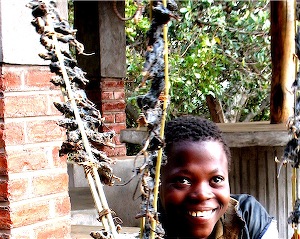A Cultural Experience – Mouse on a Stick
It is a solitary spot 15 kilometers north of the city center of Lilongwe. A white Isuzu Trooper races north from the capital and darts past the small boy standing dangerously close to the edge of the tarmac road. It is the 9th
The occupants of the vehicle, like those of the previous 9 had paid scant attention to the boy or to the food he was offering for sale. Holi lowers his split bamboo poles that sandwich in the fried mice and looks longingly toward the south for the next potential customer.
The boy, Holi Phiri is sure he is 13 years old. He comes from the Kulamula Village in the Lumbadzi area. The tribal chief over his village is T. A. Chitukla.
His Only Education Is Holding A Hoe
When an interview is arranged between Holi and an Azungu (white person) a translator is needed since he is one of the hundreds of thousands of village children who will never see the inside of an educational classroom. As Mama Cecelia Kadazamira describes it, “The only education most of the village children have is how to hold the handle of a hoe for working in the garden.”
Holi comes every other day to this same spot beside M-1 near the intersection with the airport turn off. He says it is the best place to sell his mice. Many a Galimoto passes here on their way north and south. Some days he cannot be here because the big boys push him aside and take the good spot. Holi is the only member of his family to sell mice, but his father is also a salesman and sells small amounts of sugar cane and tomatoes for the local growers around Lumbadzi. Holi has four brothers and three sisters.

.jpg)